outline
- History and meaning of commemorations in synagogues Historical Overview of Commemoration Customs in Batei Knesset, Their Development and Origins
- The different types of commemorations Description of Various Types of Hatzchot: Luchot Zikaron, Aronot Kodesh, Sifrei Torah, Luchot Tefillah and More.
- Design and art in commemorations How Design and Art Integrate in Creating Memorial Signage and Impact the Mispallelim Experience
- A spiritual and halachic view Discussion of the spiritual and halachic meaning of commemorations in synagogues.
- New technology in the field of commemorations How New Technologies Affect the Way Commemoration is Performed
- Interesting and special cases Stories about special and exciting commemorations in synagogues around the world.
- The effect of commemorations on the synagogue community How commemorations affect the community and the worshipers' experience.
- Why Should You Still Consider a Traditional Memorial Board Purchase? – The value of authentic products
- Interviews with professionals Conversations with architects, artists and designers in the field of memorials for synagogues.
- Ideas for Hanzacha (Commemoration/Memorial) From a wide spectrum of commemorations for a synagogue
The content of the article
History and meaning of commemorations in synagogues
Overview of the Development of Commemoration Customs, Including the Intermediate Period and the Evolution of Memorial Plaques and Signage
In the Temple in Jerusalem, signage was not common or done in the same way we know it today. However, there are some examples and mentions of signage or signs that were used in the Temple and its surroundings:
The Parochet between the Kodesh and Kodesh HaKodashimAlthough not signage in the modern sense, the Parochet that separated between the Kodesh and Kodesh HaKodashim in the Beit HaMikdash was symbolic and meaningful. It served as a sign of restriction that only the Kohen Gadol could pass, and only once a year, on Yom Kippur.
Luchot EvenHistorical sources mention that stone tablets were placed in various areas of the Beit HaMikdash, including tablets warning goyim not to enter certain parts of the Beit HaMikdash. The most famous reference is to a tablet warning goyim not to cross the "Soreg HaGoyim" and enter the inner courtyards of the Beit HaMikdash, preserving the kedusha of the place.
Permanent and temporary signs: There may have been additional signs in the temple to indicate certain places and functions, but there are no clear and detailed references to this in the historical sources.
In general, signage in the temple arose from the need to maintain order and sanctity, and from the need to guide the people and the priests regarding the specific procedures and customs that were required there.
The different types of commemorations
During the time of the Beit HaMikdash in Yerushalayim, the customs of commemorating those who passed away were very different from those we know today. Here are some of the main elements of commemoration during that period:
Burial and tombstones: Burial was the main way of commemorating the dead. A heavy and dignified burial was very important in Jewish culture. Sometimes, tombstones or memorial stones would be placed on the graves of the dead. The tombstones were not as rich in text and decorations as in modern times, but they served as a sign of memory.
Charity and good deeds on behalf of the deceasedOne of the common ways of commemoration was through performing good deeds or giving tzedakah in the name of the niftar. This was considered a way to continue the chain of tradition and bring honor to the neshama of the deceased.
Prayers and memories during holidays and festivals: During various holidays and festivals, such as Yom Kippur and the Seventeenth of Tammuz, various customs of remembrance and mourning were practiced, including special prayers in memory of the dead.
Sacrifices and offerings: Sometimes, sacrifices or offerings would be made in the temple as a sign of remembrance or the lifting up of the soul of the deceased.
Torah scrolls and holy itemsTrumat Sifrei Torah and other holy items to synagogues or to the Beit HaMikdash was an accepted way of commemoration.
These were just some of the ways in which they commemorated the deceased during the Beit HaMikdash period. The commemoration was founded on values of kavod (honor), memory, and dedication to tradition and community.
Since the destruction of the Temple in Jerusalem, the customs of commemorating the dead in Judaism have undergone a fascinating developmental process. Here is an overview of how this custom developed
תקופת התלמוד והגאונים (כ-500 – 1000 לסה"נ): During this period, it was customary to commemorate the deceased mainly through a heavy and dignified burial, and mainly through the placement of tombstones. Also, the habit of perpetuating the memory of the deceased through Torah study and good deeds in their name began.
The later period (1000 – 1700): In the 11th and 12th century, the development of remembrances and Kaddish in prayers began, which is reflected in the Jewish liturgy. Also, the custom of having a day of remembrance for the deceased (Yartzeit) began, where various customs are held in their memory.
The modern age (from the 18th century onwards)In the 18th and 19th centuries, additional commemoration customs developed, such as establishing buildings and institutions in memory of the deceased, like schools, hospitals and batei knesset. Additionally, the popularity of memorial plaques and signage in batei knesset began.
The modern era (from the 20th century to the present day)In the 20th century and modern era, commemoration became more comprehensive and diverse. This included modern signage, such as advanced memorial plaques, digital screens for memory and commemoration. Additionally, it became customary to commemorate people through donations to public and social causes, such as schools, community centers, and cultural institutions.
In each of these periods, the ways in which Jews chose to commemorate their loved ones evolved and changed. As time passed, commemoration became more complex and diverse, while maintaining the central values of kavod (honor), zikaron (remembrance), and masoret (tradition).
Design and art in commemorations
Memorial Boards in Batei Knesset (Synagogues) Impact the Mispallelim's (Worshippers') Experience in Several Significant Ways. Here are Some of the Central Elements of Memorial Boards that Affect the Mispallelim's Experience:
Memory and connection to the pastMemorial Boards (Luchot HaZikaron) awaken memory and connect worshippers to the community's past and to those who were part of the kehilla and have passed away. They reflect the community's history and deepen the spiritual experience.
Respect for the deadThe memorial plaques commemorate the names of the Niftarim, thus expressing kavod and appreciation for their lives and contributions. This conveys to the mispallelim a sense of respect for tradition and for community members who are no longer with us.
Educational elementMemorial plaques can serve as an educational element, especially for younger generations, in understanding the importance of memory, tradition, and respect for others.
Aesthetics and designBeautifully designed Luchot can add beauty and aesthetics to the synagogue space. Well-designed Luchot can convey a sense of kavod and appreciation, enhancing the overall atmosphere.
A sense of community and belongingThe Luchot remind worshippers that they are part of a larger kehillah, extending throughout the generations. This can help people feel a sense of belonging and connection to the community.
Commitment to memory and donationThe presence of the luchot can encourage mispallelim to contemplate their ways of contributing to the kehilla and memory, and perhaps even influence their decisions on these matters in the future.
Center for prayer and contemplationFor many mispallelim (worshippers), memorial boards serve as a place for personal tefillah (prayer) and contemplation, especially during days of remembrance or yahrzeit.
In conclusion, synagogue memorial plaques are not just a mechanism for remembrance, but also an important part of the mispallelim's experience, adding to the spiritual and communal atmosphere, and deepening one's connection to the holy place and their kehillah.
A spiritual and halachic view
Memorial Plaques in Batei Knesset: Important Halachic Aspects
Prohibition of idolatry and living imagesIn Jewish Halacha, there is a prohibition against avodah zarah (idol worship) and displaying tzlamim (living figures/images) in the Beit Knesset. Therefore, memorial plaques must avoid containing pictures of people or figures.
Preservation of the principle of equality in the communityIt is important to ensure that memorial plaques do not create an impression of preference or distinction between community members based on financial ability or social status.
Determination of community regulationsIn every kehillah there can be unique takanot and minhagim that determine how to handle matters of commemoration. These rules should be followed according to the spirit of halacha and local minhag.
New technology in the field of commemorations: The effect of new technology on commemorations, such as the use of digital screens.
The effect of new technology on commemorations in synagogues
Flexibility and up-to-dateDigital screens enable real-time data updates with ease. This includes adding or modifying names on memorial boards, updating Yahrzeit dates, and additional information.
Interactivity and enrichment: Digital screens can provide an interactive experience with in-depth information about the deceased, such as life stories, photos, and even videos.
Space saving and mobility: Digital screens can save significant physical space in the synagogue, thus allowing more space for other needs. Also, they are portable and can be placed in different places as needed.
Modern aesthetics: The combination of modern digital technology can give the synagogue a contemporary and aesthetic look.
information accessibility: Digital screens make information accessible to a wider audience, including support for different languages and options for personalizing the displayed information.
Privacy and control: Digital systems allow a higher level of control over the information presented, and can offer solutions to the issues of privacy and information security.
In summary, the new technology, especially the use of digital screens, is transforming the face of commemoration in synagogues (batei knesset) and provides new and advanced ways for remembrance, memorialization, and the worshippers' (mispallelim) experience.
Why Should You Still Consider a Traditional Memorial Board Purchase?
Traditional Memorial Boards (Luchot HaHantzacha HaMasortiim) offer several significant advantages over digital memorial boards
Authenticity and traditionTraditional Memorial Plaques carry emotional significance and authenticity. They are connected to an ancient tradition and provide a sense of kedushah and history.
luxury and eleganceThe use of materials such as nechoshet (copper), brass, etz (wood), or glass for creating traditional memorial plaques creates a sense of luxury and elegance.
Adjustment to the atmosphere in the synagogueTraditional Memorial Plaques often harmoniously integrate with the design and atmosphere of older or traditionally-designed batei knesset.
Keeping it simple and focusedWhile digital screens can be advanced and impressive, traditional memorial boards preserve simplicity and focus that allow mispallelim to concentrate on tefillah and spiritual contemplation without distractions.
Reducing dependence on technologyTraditional Yahrzeit/Memorial boards do not require electricity or technological maintenance, and therefore are less dependent on technical malfunctions or the need for frequent updates.
In summary, traditional Luchot HaHantzacha (memorial plaques) bring advantages of authenticity, durability, elegance, spiritual atmosphere compatibility, simplicity, and independence from technology.
Interesting and special cases:
Stories about unique and exciting commemorations in synagogues around the world inspire and connect us to history and tradition. Here are some examples:
Commemorating the victims of the Holocaust in PolandIn several batei knesset in Poland, complete memorial dimensions and special memorial plaques were built to commemorate Jewish kehillot that were destroyed during the Holocaust. For example, in the beit knesset of the Tykocin kehilla, a memorial plaque was created commemorating the names of the Jews who lived in the shtetl before the Shoah.
"Memory of Joseph" Synagogue in Ireland: This synagogue in Dublin commemorates Yosef Biov, a local Jew who was murdered in the 1920s. The Jewish community there created a living memory in his name, and the synagogue became a focus for study and remembrance.
הנצחת קורבנות הפיגוע בפיטסבורג, ארה"ב: After the terrible attack on the "Etz Haim" synagogue in 2018, in which 11 worshipers were murdered, the local community and the global Jewish community united to create a permanent memorial to the victims. This included art projects, digital memory, and learning.
בית הכנסת של קהילת חב"ד בתאילנד: In Chiang Mai, Thailand, a special synagogue was built to commemorate a Jewish couple killed in a terrorist attack in Mumbai in 2008. The synagogue served as a symbol of life and hope in a place where tragedy occurred.
The "Ma'ale Hayim" synagogue in Brazil: In Brazil, a synagogue was built dedicated to the memory of a child who died of a serious illness. The synagogue was built by the family and serves as a place for study and prayer, and as a meeting place for children and youth in the community.
Through these commemorations, communities around the world preserve the memory of the past and pass it on to future generations, while creating meaning and spiritual and communal connection.
The effect of commemorations on the synagogue community
Diyun b'hashpa'at ha'hantzacha al kehilat Beit HaKnesset v'hamitpallelim (Discussion on the impact of memorialization on the synagogue community and worshippers)
A conversation with an architect specializing in the design of synagogues
question: "What are the main challenges in designing a space for commemorations in a synagogue?"
answerThe challenge is to balance between the desire to commemorate and maintaining the kedushah and spirituality of the Beit Knesset. We must maintain delicacy and kavod in design, while creating a space that allows mispallelim to connect with the commemoration in an emotional and spiritual way.
A conversation with an interior designer who specializes in synagogues
questionHow do you deal with the need to incorporate commemoration in a way that doesn't interfere with the tefillah experience?
answerI strive to use materials and colors that blend harmoniously with the existing space. Each memorial project is unique, and I emphasize the uniqueness of the person or group being commemorated.
Conversation with an Artist who Created Memorial Plaques
questionWhat guides you in choosing the design and materials for Luchot Zikaron?
answerI focus on combining beauty with simplicity. It's important to me that the luach (board) be both impressive and modest, reflecting the memory and kavod (honor) intended for the niftarim (deceased). I work with various materials, from wood and glass to metals and stone.
A conversation with a digital commemoration expert
question: "What is the motivation to integrate digital commemorations in synagogues?"
answer: "Technology allows us to create commemorations that are more flexible and accessible. They can be updated easily, and they allow an innovative and interactive experience for worshipers. It also solves the problem of space limitations in small synagogues."
Each sicha (conversation) provides a glimpse into the creative process and various considerations of each memorial expert. Through this, we can better understand the complexity and richness of synagogue commemorations.
Ideas for Hazkara (Memorial) Products
The veil, the curtain that decorates the opening of the Ark of the Covenant, is one of the central items in every synagogue. The design of a parochet can reflect the spirit of the community, especially when it is dedicated to the memory of a donor or to uplift the soul of a loved one of the community. A dedicated veil is not only a decorative item but also a means of expressing respect and appreciation.
A Torah scroll bag is not only a protective cover but also a way to commemorate a personality or an important event in the life of the community. These bags can be customized with quotes, or symbols that represent the spirit of the community.
Donors Board and Memorial Board
Donor Board and Memorial Board are permanent elements in synagogues (batei knesset), enabling the commemoration of donations and remembrance of departed community members. This form of commemoration allows for accessible and continuous remembrance, and helps raise new donations while honoring donors.
Prayer Boards (Luchot Tefillah) Add Spiritual Dimension and Enrich the Prayer Experience in the Beit Knesset. These Boards Can Contain Tefilot Such As Orphan Kaddish, Thanks Durbanan, The blessings of the Torah and Haftarah, and they are a constant reminder of the meaning and values of the prayers that the community says together.
The throne of Elijah the prophet
Kisei Eliyahu HaNavi (Chair of Elijah the Prophet) serves as a central symbol in Jewish tradition, primarily in Brit Milah ceremonies. These chairs are offered in traditional and modern designs and serve as commemorative items for significant people and events in community life. Kisei Eliyahu can be customized and may include woodwork, embroidery, and paintings incorporating Jewish elements. They add prestige and meaning to the synagogue and strengthen the community's spiritual connection to tradition.
For Gallery of Memorial Plaques Click Here
-

An artistic tree of life
1,863.10$ Click to purchase -
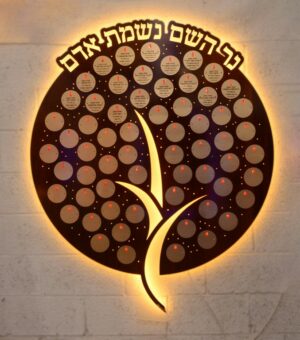
Modern Stars Memorial Wood Board (Luach Zikaron)
2,018.36$ Click to purchase -

Memorial Plaque "Zochrenu L'Chaim"
3,664.10$ Click to purchase -

Randomali Memorial Plaque
2,949.91$ Click to purchase -

tree of life birds cypress
2,018.36$ Click to purchase -
Sale!
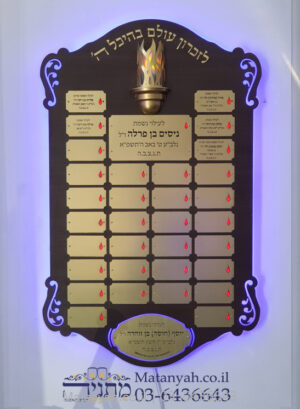
Memorial and Remembrance Board Chevron
Original price was: 1,397.32$.1,226.54$Current price is: 1,226.54$. Click to purchase -
Sale!
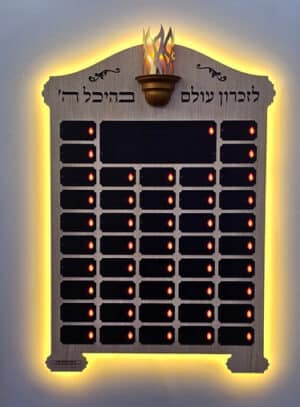
Memorial Board Sha'ar Hashem
Original price was: 1,242.07$.1,086.81$Current price is: 1,086.81$. Click to purchase -
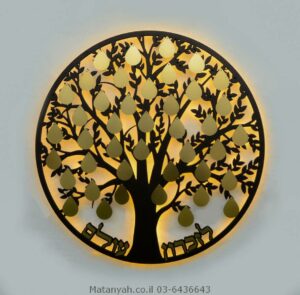
Memorial Tree - Tal HaChaim
1,397.32$ Click to purchase -
Sale!
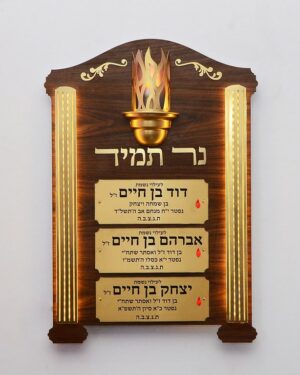
A candle always pages 3 dedications
Original price was: 869.45$.683.14$Current price is: 683.14$. Click to purchase -

A tree of life for the uplifting of the soul
3,291.48$ Click to purchase -
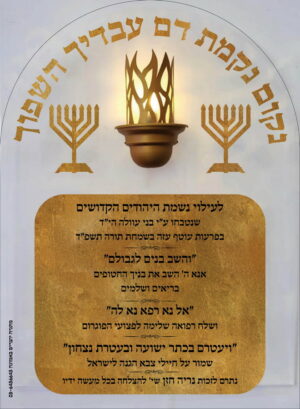
A candle is always elegant and transparent
Price range: 527.88$ through 621.03$ Click to purchase -

Tree Donors Tree of Knowledge